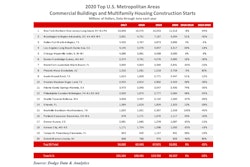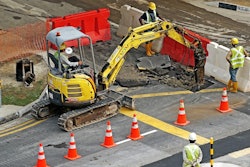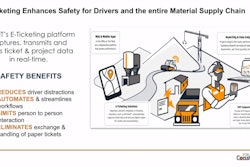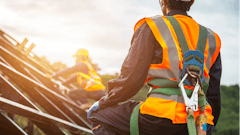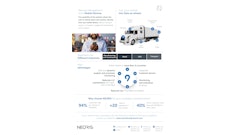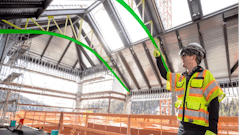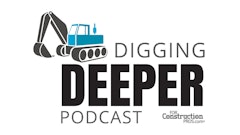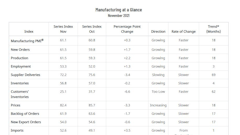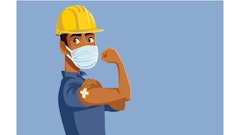
Adversity always creates its fair share of challenges for leaders. Whether or not these challenges can be dealt with successfully often depends upon how adversity is viewed – either as a threat to overcome, or as an opportunity to improve and advance.
Mike Ballweber has opted for the latter approach when it comes to his response to the ongoing impacts of the COVID-19 pandemic. As an equipment manufacturing industry leader, the president of Doosan Bobcat North America is making a concerted effort to focus on the realities and the opportunities ahead, as the pandemic continues to impact his company and the dealers and customers it serves. And in embracing an optimistic and forward-thinking mindset, Ballweber is starting to see all of the different ways in which Doosan Bobcat can continue to operate efficiently and effectively – no matter what comes the company’s way.
“I’ve been very proud of our organization because we’ve focused on the health and safety of our team first and then on how can we can emerge from the pandemic stronger and a more successful company,” said Ballweber. “Much of the nation’s daily life may have changed, but our customers and dealers are not standing still; they are working hard and making changes to survive and thrive as essential businesses. This means we have to be there for our dealers and customers and ask how we can support them to continue moving forward.”
A flexible approach
The last several months have been anything but easy for Ballweber and Doosan Bobcat, but a willingness to remain flexible as circumstances continue to evolve with time has been critical to the company’s ability to deal with the challenges posed by the COVID-19 pandemic.
When Doosan Bobcat shut down its manufacturing operations for two weeks in April, company officials quickly responded and utilized the downtime as an opportunity to implement the proper safety measures and protocols to ensure the well-being of their employees upon their return. As a result, while Doosan Bobcat has had positive cases, there have been no mass outbreaks of COVID-19 at any of the company’s facilities.
“We worked closely with employees at our factories to make sure they were onboard with what we wanted to do,” said Ballweber. “The safety of our employees is paramount. It’s our top priority, and that has not – and will not – change.”
However, because Doosan Bobcat operates facilities in several states throughout the United States – North Dakota, Minnesota, Wisconsin, North Carolina, Georgia and Colorado – it became clear, even in the earliest days of the pandemic, that company officials couldn’t adopt a one-size-fits-all response to COVID-19.
“North Dakota, for example, hasn’t been impacted nearly as much as other states, so we’ve been able to bring employees working remotely back to offices sooner,” said Ballweber. “But in North Carolina and Georgia, I can tell you that’s not the case.”
It also became evident early on to Ballweber and his fellow leaders at Doosan Bobcat that no two employees feel exactly the same about the pandemic, its impacts thus far, and how to respond to it.
“It really runs the gamut,” explained Ballweber of the feedback he has heard from employees. “Some employees want us to proceed with operations as usual, while others are worried, feel vulnerable, or they are worried about a parent or family member deemed high risk. Given this, we’ve tried to be as accommodating and as flexible as we can be with everyone.”
While Ballweber and his organization managed the office staff working remotely, that simply isn’t a viable option for those who work in production.
“The manufacturing work environment is unique, as our equipment must be produced in our factories,” he said. “Therefore, we have stayed focused on protecting the health and safety of our team members and putting new protocols in-place. So, if I look at potential challenges of the pandemic going forward, I must first consider our workforce. We have thousands of employees across the country, in different roles, of all ages and various health considerations. Figuring out how we manage through this, while continuing to move our business forward is the challenge.”
Importance of communication
Regular and consistent communication with employees, suppliers and customers has been a critically important tactic in ensuring Doosan Bobcat has been able to successfully deal with impacts of the pandemic and certain operational challenges in 2020.
Communication has also played a key role in helping Doosan Bobcat combat workplace disconnect and boost employee morale. In the early stages of the pandemic, the company set up a special landing page on its intranet site for employees for the latest information, and team members were encouraged to connect with one another via virtual meetings and on its digital platforms. In addition, Ballweber distributed regular communications to all employees and he and other leaders conducted videoconference briefings and webinars to share updates and keep in contact with the workforce.
“When you have to work remotely, it is easy to feel disconnected, especially when you’re used to working in an environment where collaboration and in-person meetings are the norm,” he explained. “From our production teams to office employees, it is important to me that everyone continues to feel connected to their coworkers and to the company, and that they understand their work truly matters to the Doosan Bobcat’s success.”
Ballweber has also been inspired by the way employees have responded to serve the community during the pandemic. In April, members of the engineering team produced much needed protective face shields for health care providers and those serving in senior living facilities.
“This is a testament to the skill and character of our teams, as well as their commitment to our local communities,” said Ballweber.
A focus on continuous improvement
Looking to the future, Ballweber said Doosan Bobcat is currently in the midst of 2021 planning efforts, and that he can’t recall ever seeing so many different variables and scenarios when trying to predict volumes for the coming year.
“It’s just all over the board,” he continued. “Historically, we can look back at other times when the industry has been down. And if you do enough modeling, you can usually come up with a fairly realistic idea of what things will look like in the future. However, with this pandemic, it’s all very different, so we’re definitely dealing with uncharted territory right now.”
If there is one thing Ballweber is sure of, though, is he and Doosan Bobcat employees work most effectively when they are together. As a result, company officials have worked diligently to bring the workforce back to the office safely and with a variety of established safety protocols in-place to ensure their well-being, all while maintaining a mindset of continuous improvement and innovation in the face of adversity.
“I think we’re doing a lot of things you see from other companies, but we’re really looking at things from an opportunistic standpoint. The crisis has required us to look at things differently. We want to be certain we’re doing everything we can to move our business forward in a number of different areas,” he said.
“What we’ve tried to do throughout this pandemic is really try to manage three things at the same time,” continued Ballweber. “First, protecting the health and safety of our employees and the communities where we operate. Second, providing support to our dealers and customers. And third, protecting the continuity of our business and ensuring we are making the best decisions for the long-term. I firmly believe we have the opportunity to come out stronger on the other side.”





